Google's Tensor inside of Pixel 6, Pixel 6 Pro: A Look into Performance & Efficiency
by Andrei Frumusanu on November 2, 2021 8:00 AM EST- Posted in
- Mobile
- Smartphones
- SoCs
- Pixel 6
- Pixel 6 Pro
- Google Tensor
GPU Performance & Power
The Google Tensors GPU is quite a beast. A Mali G78 with 20 cores, it’s sporting 42% more cores than the Exynos 2100 implementation, and only comes second after HiSilicon’s Kirin 9000. However, unlike the more power efficient N5 process node of the Kirin 9000, the Tensor SoC comes on the same process node as on the Exynos 2100. Having a much larger GPU, one would expect Google to drive the block at lower frequencies, in order to achieve better energy efficiency. To our surprise, the G78MP20 runs at up to 1GHz on the tiler and L2, and up to 848MHz on the shader cores, which is essentially the same as the smaller Exynos 2100 implementation of the GPU. Of course this immediately raises red flags for the Tensor when it comes to power consumption, as the chip certainly can’t pull out a rabbit out of a hat in terms of efficiency, so let’s see what happens:
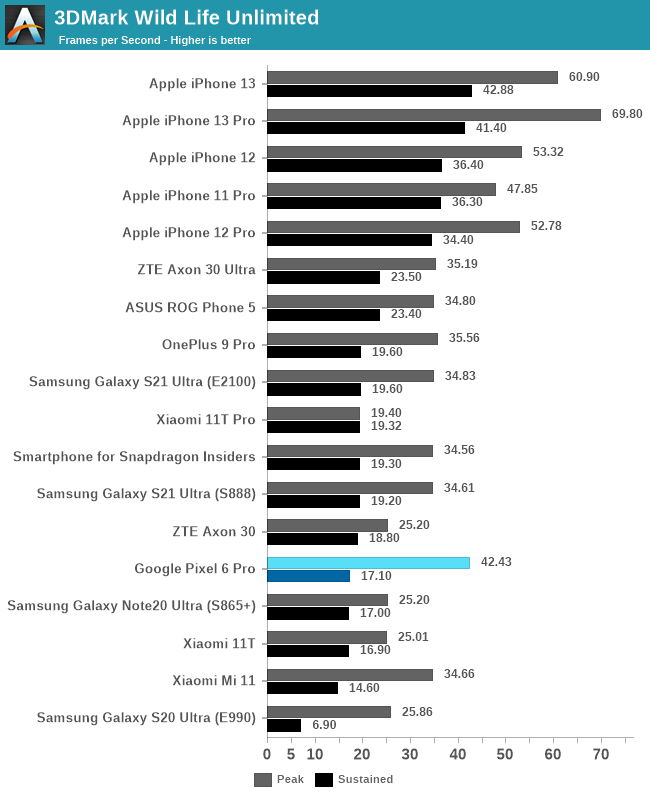
In 3DMark Wild Life unlimited, the first thing to note is that for some reason the regular Pixel 6 didn’t want to run the test as it errored out due to memory – I’m not sure what happened here, but it was isolated to the baseline model as the Pro unit had no issues.
The Pixel 6 Pro’s peak performance is respectable, however it’s only 21% faster than the Exynos 2100, not exactly what we’d expect from 21% more cores. A large issue with Mali GPUs of late has been that while you can throw more shader cores at the issue, the shared resources such as the tiler and L2 still remain as a single unit on the GPU. The G78’s ability to clock this part of the GPU higher is taken advantage of by Google in the Tensor implementation of the GPU, however that’s only 16% faster in pure clock frequency – maybe the workload is bottlenecked somewhere in this part of the GPU architecture.
Sustained performance off the start doesn’t look too good for the Pixel 6 Pro as it throttles considerably once the device gets hot, more on this in a bit.

In Basemark GPU, the Pixel 6 phones both showcase odd peak performance figures that are way lower than we expected, here the chip doesn’t even manage to outperform the Exynos 2100. I’m not sure what the technical explanation here is, as on paper, the chip should be faster.

In Aztec High, the peak performance of the Tensor is again below what you’d expect, at +14% vs the Exynos 2100, and slightly ahead of the Snapdragon 888.
Sustained performance is quite bad here, and especially the Pixel 6 Pro seems to be running more severe throttling than the Pixel 6.
Looking at the power consumption of the phones, at peak performance, the Pixel 6 lands in around 7.28W, however this figure is a bit misleading. In actuality, the phone is running peak power figures in excess of 9-10W, but this is so much power, that the SoC isn’t able to complete a single run of the benchmark without throttling, so average power for a given run is actually much lower. This would also explain as to why our peak performance figures are less than what’s expected of a GPU clocked this high, it simply can’t maintain that speed for long enough to give off an FPS figure at the peak frequencies.
At sustained frequencies, the Pixel 6 and Pixel 6 Pro end up with different spots, however both are at quite low power figures around 3W.

Aztec normal shows similar results, peak performance of the GPU is barely any better than the smaller configuration Exynos 2100 unit, and sustained performance figures are also significantly lower.
Sustained power after throttling on the phones is also quite weird here, as the phone seemingly throttles to <3W on the SoC. The Pixel 6 for some reason appears to have better power characteristics, it’s possible that chip bin has lower power than my 6 Pro unit.

Manhattan 3.1 shows a similar peak and sustained performance standing, which isn’t too favourable for the Tensor.
Power levels in Manhattan are higher than the Aztec benchmarks, I think the CPUs, or the DRAM contribute to more of the power due to the higher achieved framerates, and it slightly helps the heat dissipation rather than having everything focused on the GPU.
Overall, the GPU performance of the Google Tensor is quite disappointing. On paper, the massive G78MP20 GPU seemed like a juggernaut at the frequencies Google delivers the chip in, but in practice, it doesn’t reach the theoretical levels of performance. That being said, over the last year of SoC releases, almost every vendor in the industry has introduced some absurd ultra-high-power GPU configuration that throttles quickly. Why they do this, I don’t know, GPU compute for burst performance is always one of the reasons given, so maybe Google is also aiming the GPU towards compute rather than gaming.
In terms of sustained performance levels, the larger GPU in theory should have allowed it to run at lower frequencies, thus at better efficiency, and in turn deliver more performance than a smaller implementation like that of the Exynos 2100. The reality here is that the Pixel 6 phones struggle with thermal dissipation, and it’s something that seems to be completely unrelated to the chip itself.
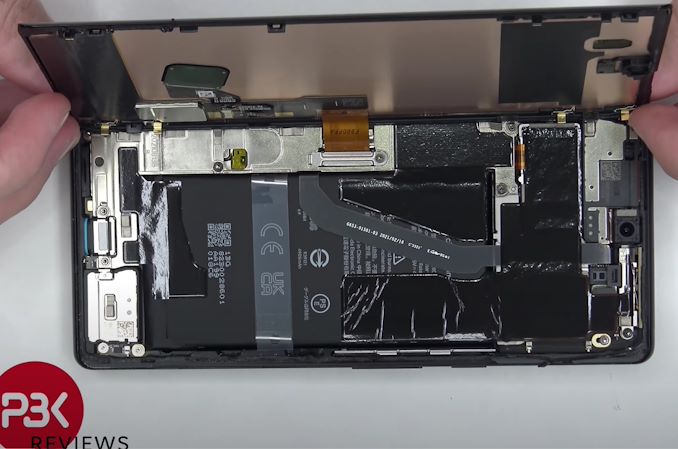
Source: PBKreviews
Both the Pixel 6 and Pixel 6 Pro are quite special in their hardware designs, in that they’re one of the rare Android devices out there which adopt an internal hardware design which doesn’t have a midframe adhered to the display panel. Looking at various teardowns of the phone, we can see that the display is relatively easily removable from the rest of the phone body, a design that’s actually more similar to Apple’s iPhones than any other Android flagship. This bodes well for the repairability of the screen, but it doesn’t do well for the thermal dissipation of the SoC. Much like iPhones have issues with thermal dissipation, and having much lower sustained power levels under stress, the Pixel 6 phones also suffer from the same issue as they cannot effectively use the display panel as a heat sink. This comes in contrast with other flagship Android devices – the Galaxy S21 Ultra for example has its display panel adhered to the midframe of the phone, it's not great for repairability, but it allows Samsung to employ a gigantic thermal dissipation pad the size of half of the phone footprint, with a direct heat pathway from the SoC to the display. Other thermally optimised devices out there share similar designs, able to better dump heat onto the full body of the phone.
The Pixel 6 Pro in contrast, has quite stark heat spots, with the left side of the phone, near the SoC, getting quite hot at up to 45°C, but at the same time the right side of the device here barely reaches 30-33°C, which is a large temperature gradient and signifies bad heat transfer abilities. Also, while I’m not sure how other people feel about this, but it does make the Pixel 6 phones feel more “hollow” in their build quality, but that might just be a nit-pick.
In any case, the Google Tensor’s chip gaming performance might be adequate, it’s no better than the Exynos 2100, and it gets further handicapped by the thermal design of the Pixel 6 phones. Generally, one can say it’s not the best phone for high-end gaming, which lines up with the subjective experiences with the devices in actual gaming demanding games like Genshin Impact.


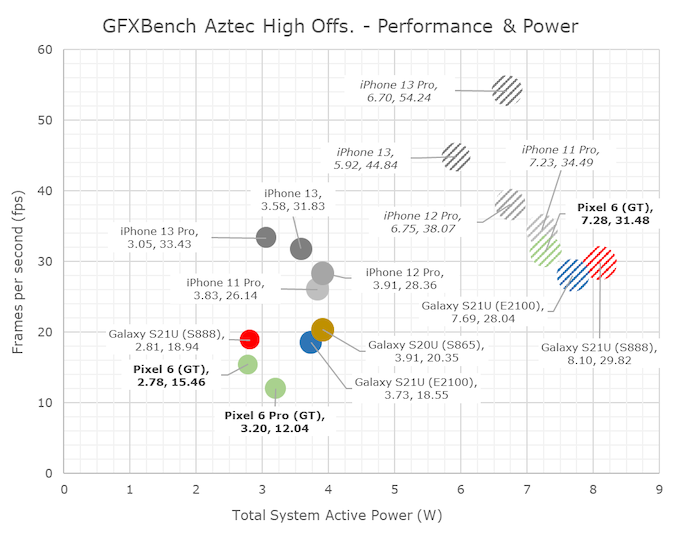
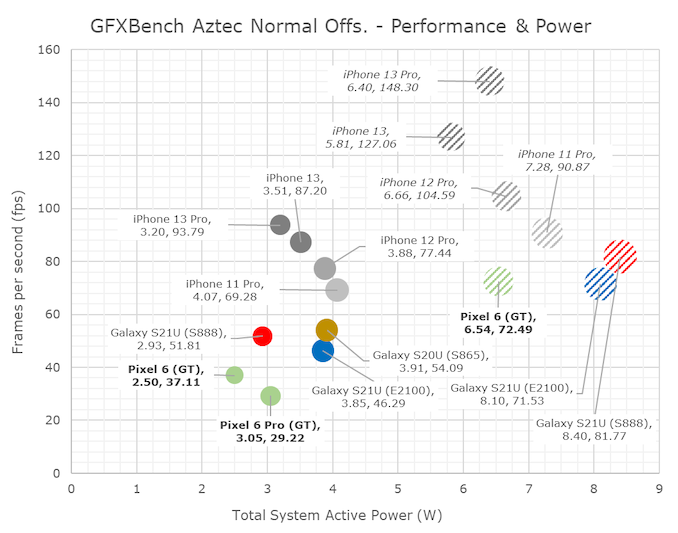
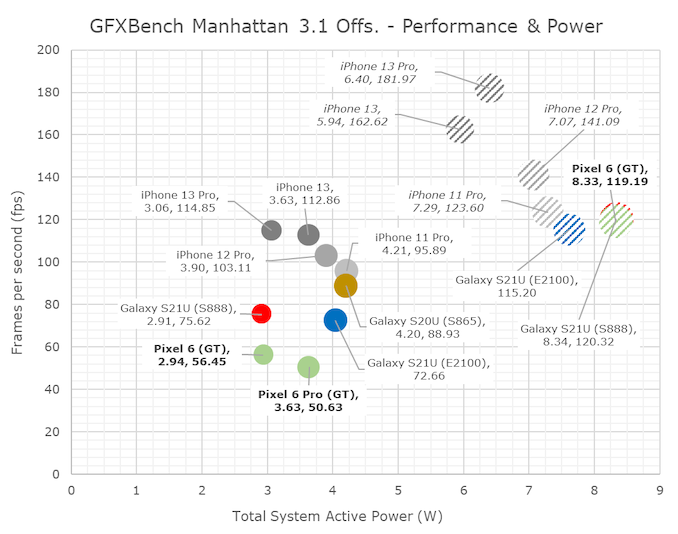








108 Comments
View All Comments
sharath.naik - Thursday, November 4, 2021 - link
Good in-depth review. I know you are doing the camera review of this. So I have a request can you look into if the Pixel 6 cameras are hardware binned to ~12MP even though the specs say they are 50MP/48MP. There is a lot of mixed views out there, most mistaking this as the pixel binning done on other phones like galaxy S21u(Software binned for low light but has access to full resolution). If you could confirm this for the review would be great, looking forward to that review.Silver5urfer - Tuesday, November 2, 2021 - link
Exactly as expected 1:1The SoC is a bust, they tried to do some gimmickry with their zero talent and tried to make it a cheaper deal by going to Samsung for their IP fabrication expertise and lithography process. Ended up being a dud in CPU, GPU and price to performance, all that NPU NN, mega magic boom is all a farce. I was asking the same thing, what does these provide to us end users ? Nothing. Just that fancy Livetranslation and other gimmicks which you use seldom. On top we do not even know what TPU does in the Pixel Software, it's closed source. AOSP is open but Pixel UI and all backend are closed.
Hardware is utter joke, the P6 series has garbage mmwave system look at the internals, they crammed one lol. LG V50 back in 2019 had 2-33 mmwave antennas. This junk saved on cost. The display has banding issues all over the place. Optical image sensor for Fingerprint is slow and a joke vs the physical dedicated ones. The stereo speaker system has massive channel imbalance on top. Then you have the low battery SoT for this price point and battery capacity. The DIY aspect is thrown into gutters, the phone has massively hamfisted cooling approach with graphite pads smeared all over the place as leaks showed and no proper HS system it's just a small pathetic AL board reinforcement plate doing it so on top the Display has no metal backplate to reinforce it or dissipate heat. What a nonsense. SD888 itself heats up a lot and so many vendors add VC cooling, Sony Xperia 1 Mark 3 messed up there and had inferior performance with throttling. This junk is even more pathetic, pay for a S tier SKU get trash sustained performance of a B+ device, the AP, Pocket now and other Youtube shill press will hype this to moon.
We do not even know how this junk has in terms of Software blocks like P2, P3, P4 had A/B system, then merged partitions, later read only ext4 system. This will have even worse. To make it a round about trash, the software is a joke cheap kiddo inspired garbage, heck that BBKs OnePlus's Oxygen + Oppo Color OS mix is way superior than this junk with massive information density loss.
I'd wait for the next SD successor device, hopefully 888's BS power consumption and insane heat can be reduced.
Silver5urfer - Tuesday, November 2, 2021 - link
It's a typo for mmwave, it's 2-3 units. Also I forgot to mention the lack of charger, SD slot, no 3.5mm jack very poor servicing almost impossible to get the phone properly cooled if you open it due to cheap graphite pad reliance. It also has that USB port and microphone soldered to the mainboard which looks like a feeble trash unit check any phone in the recent times and look how solid engineered they are, dual sandwich designs with reinforced chassis and proper heat dissipation.goatfajitas - Tuesday, November 2, 2021 - link
People get WAY too hung up on benchmarks. LOL, a "dud". A phone is about user experience, not how many "geekmarks" = best.lionking80 - Tuesday, November 2, 2021 - link
I agree that the benchmarks do not tell the whole story, but I would still say that even the use of a Snapdragon 870 would have been a better choice.The general performance is similar (maybe a small advantage for Tensor in AI), but the advantages of Snapdragon 870 are bigger: runs much cooler, hugely better battery-life.
To be honest I am disappointed by the SOC. The only thing that might make it a seller is the software (ui and camera), but the SOC is rather a no-go.
goatfajitas - Tuesday, November 2, 2021 - link
There are other factors though. Early ROM settings, tweaks, bugs, and cooling/hardware. The 870 may have scored lower in a P6 as well. So many factors. - Agreed, the P6 should be a bit more polished though.at_clucks - Tuesday, November 2, 2021 - link
The problem goes beyond the slightly worse SoC than the already existing Qualcomm offering. It's that despite being a "Google SoC" they still support it for just 3 years. All the excuses used over the years, all the pointing fingers at SoC manufacturers for the lack of support were just proven to be a load of crap. Same crap, now with a google sticker.sharath.naik - Tuesday, November 2, 2021 - link
It's about to get worse with the camera review. I can verify Google might have been bluffing about the 50mp/48mp sensors. The sensors are locked at 12mp. So Pixel pro has essentially three 12 mp cameras. Which means the portrait mode zoom of 2x is a low resolution 3 MP image. Also at 10x zoom the image resolution is 2.5MP, 4 times lower than that of s21 ultra. What drove Google to make the choice of first hardware pixel binning the resolution down and then trying to digitally blow the resolution backup!!.It's baffling, tried to get an answer from Google support, they just refused to confirm or deny this is binned at the hardware levelhoxha_red - Tuesday, November 2, 2021 - link
"I can verify that google might have been bluffing"dude, lmfao—it's called "binning"; please look it up. they've been upfront about this and it was known before the phone was even launched, let alone after we've seen all of these reviews. The reason Google support "refused to confirm or deny" is because the people doing customer support are unlikely to know what "pixel binning" is (hey, I guess they're in good company there with you), and are not equipped to deal with weirdos of your specific variety.
Maxpower27 - Tuesday, November 2, 2021 - link
You obviously have no familiarity with mobile phone cameras and sensors in particular. Read up about them and then try again.